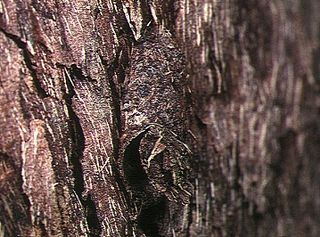
The wafer trapdoor spiders, family Cyrtaucheniidae, are a widespread family of spiders that lack the thorn-like spines on tarsi and metatarsi I and II found in true trapdoor spiders (Ctenizidae).

Nemesiidae, also known as funnel-web trapdoor spiders, is a family of mygalomorph spiders first described by Eugène Simon in 1889, and raised to family status in 1985. Before becoming its own family, it was considered part of "Dipluridae".

Sason is a genus of bark-dwelling brushed trapdoor spiders first described by Eugène Simon in 1887. It is distributed from the Seychelles through India to northern Australia. The closest related genus seems to be the monotypic Paracenobiopelma.

Idiops is a genus of armored trapdoor spiders that was first described by Josef Anton Maximilian Perty in 1833. It is the type genus of the spurred trapdoor spiders, Idiopidae. Idiops is also the most species-rich genus of the family, and is found at widely separated locations in the Neotropics, Afrotropics, Indomalaya and the Middle East. Females live in tubular burrows lined with a thick layer of white silk. These typically have a D-shaped lid that fits into the entrance like a cork, and some burrows have two entrances. The lid may consist of mud, moss or lichen, which is bound below by a thick layer of silk. As in all genera of this family, the anterior lateral eyes (ALE) are situated near the clypeal margin, far in front of the remaining six eyes, which are arranged in a tight group. The males which are smaller in size, wander about or occasionally live in burrows. Like other mygalomorphs, they are relatively large and long-lived. Forest clearance and agricultural practices that loosen the soil and enhance erosion, besides soil removal for brick making have been pointed out as serious threats to some Indian species. Species ranges are poorly known – in India for instance, most species are known only from their type localities.

Poecilotheria striata, or the Mysore ornamental tarantula, is a large arboreal tarantula of the family Theraphosidae. It is endemic to India.
The Ischnocolinae are a problematic subfamily of tarantulas. In 1892, Eugène Simon based the group, which he noted was only weakly homogeneous, on the presence of divided tarsal scopulae. This feature was later considered to be plesiomorphic, and both morphological and molecular phylogenetic studies have shown that, as traditionally circumscribed, the subfamily is not monophyletic. A much more narrowly defined Ischnocolinae sensu stricto was proposed in 2014. One of the authors of that proposal subsequently said that no further taxonomic changes should be considered until there had been a more comprehensive sampling of the subfamily. As of January 2021, the status of the Ischnocolinae remains unresolved.
Neoheterophrictus uttarakannada is a species of spiders in the genus Neoheterophrictus from India. It was first described in 2012 by Manju Siliwal, Neha Gupta, & Robert John Raven. Its name comes from the place where it was discovered, Uttara Kannada.

Neoheterophrictus is a genus of tarantula in the family Theraphosidae. It comprises seven species, all found in India.
Neoheterophrictus bhori is a species of tarantula. It is native to Parambiculam, Western Ghats, Cochin province, India.
Neoheterophrictus crurofulvus is a species of tarantula. It is also the type species of Neoheterophrictus and is found in the Western Ghats, India.
The Eumenophorinae are a subfamily of tarantula spiders. They are known from genera distributed across Africa, southwestern countries in Saudi Arabia, and Madagascar and the associated islands.
Diplothele is a genus of mygalomorph spider in the family Barychelidae, containing four species restricted to India and Sri Lanka.
Plesiophrictus is a genus of tarantulas that was first described by Reginald Innes Pocock in 1899.
Tigidia is a genus of brushed trapdoor spiders first described by Eugène Simon in 1892.

Conothele is a genus of mygalomorph spiders in the family Halonoproctidae, first described by Tamerlan Thorell in 1878. Originally placed with the Ctenizidae, it was moved to the Halonoproctidae in 2018.
Damarchilus is a genus of spiders in the family Nemesiidae. It was first described in 2015 by Siliwal, Molur & Raven. As of 2017, it contains 2 species, both from India.

Crassitarsae is a clade of avicularioid mygalomorph spiders first proposed by Robert J. Raven in 1985, based on a morphological cladistic analysis. Raven characterized the clade by a number of shared features, including the presence of some scopulae on the tarsi. The clade has been supported to some degree by subsequent molecular analyses, although with a somewhat different composition.







